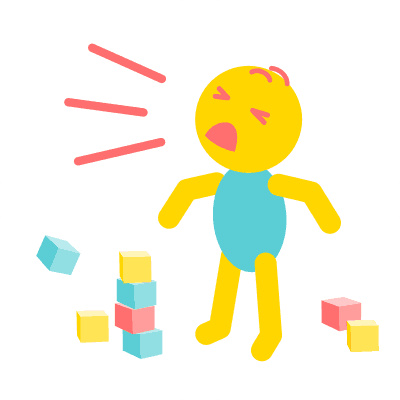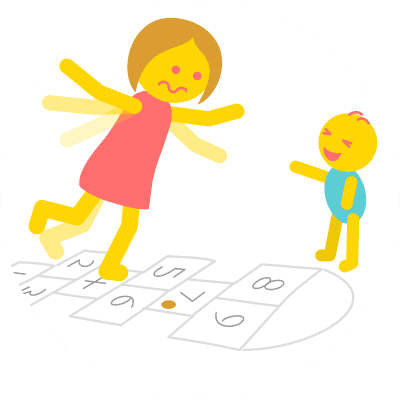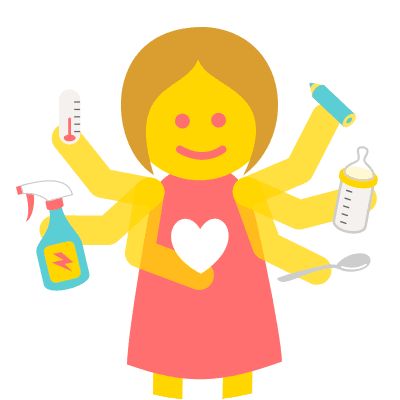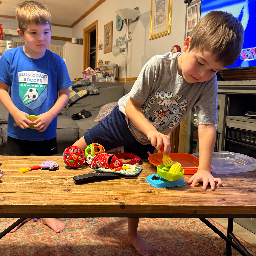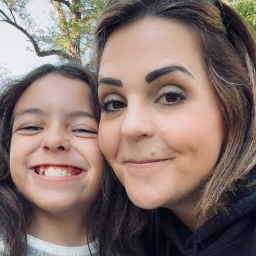How to Calm an Upset Child (17 Tantrum Tips for Babysitters)


Written & Illustrated by
Matthew James Taylor
Kidsit Founder, General Manager

Babysitting video by
Lydia Kutz
Babysitter, Infant Swimming Resources Instructor

Medically Reviewed by
Gina Maria Jansheski, MD, FAAP
Board-Certified Pediatrician, Medical Reviewer
Key Takeaways
- Stay Calm and Present: Your composure can help de-escalate the situation. Speak in a gentle tone and maintain a calm demeanor.
- Identify Triggers: Understanding the cause of the upset can guide your response. Whether it's hunger, tiredness, or frustration, recognizing the trigger is crucial.
- Provide Space if Needed: Sometimes, children need a moment alone to regain composure. Ensure they're in a safe space and allow them to calm down independently.
- Use Distraction Techniques: Engage the child with a favorite toy, game, or activity to shift their focus and soothe their emotions.
- Validate Their Feelings: Acknowledge the child's emotions by saying things like, "I understand you're upset because..." This shows empathy and helps them feel heard.
- Set Clear Boundaries: Explain acceptable behaviors calmly. For instance, "It's okay to feel upset, but it's not okay to throw toys."
- Offer Comfort: Depending on the child's needs, a comforting touch, a favorite blanket, or soft music can help soothe them.
- Communicate with Parents: After the incident, discuss with the parents to understand any specific strategies they use and to ensure consistency in caregiving.
Babysitting a calm and content child is reasonably straightforward. But I know that when a child gets upset, you really have your work cut out for you as a babysitter. Here are a few hints on different ways to try and calm them down.
How can babysitters calm an upset child? Kids can get upset for many reasons. They could be angry, sad, scared, or hurt. Identifying why they're upset to begin with is a great place to start. Then you can distract them, sympathize with them, or give them a safe outlet for their anger accordingly.
In this article, I'll give you strategies to help calm an upset child. I'll help you figure out how to determine what triggered them and prevent or de-escalate upset kids before the situation develops into a full-blown temper tantrum.
Lydia has been working in the childcare industry for 15 years, and owned a childcare agency in Florida, USA for 7 years. She has many years of experience babysitting younger children who are prone to temper tantrums, in this video she gives her advice for how to deal with them
How To Deal With A Tantrum
Lydia Kutz has experienced many tantrums over her babysitting career and has developed several tactics for dealing with this kind of behavior. She describes a particularly difficult two-hour tantrum below and explains how she handled the situation calmly and effectively:
The biggest tantrum I've ever seen, I was working with a 2-year-old and he threw a tantrum for two hours. Two hours of kicking, screaming, yelling, and throwing things, I was about to start throwing a tantrum with him, it was pretty bad. But with big tantrums, you've got to stay calm through it.
It can be hard and difficult when things are being thrown, when you're being kicked, or spit on, or hit, or they're going to hit other people, maybe the sibling in the same room, or anybody in the room with them. If they are going after somebody else or you, or throwing things, that's what I call the big tantrum, the big bomb. I make sure they understand that this is not ok right away, we do not throw our toys, we do not put our hands on other people. And that's where I take them from a bigger room, such as the living room, to their room where they are away from everybody else.
Depending on the child and the parents' discipline preference I will close the door and sit right outside the door so I hear what's going on inside the room but they're contained and they can take time to chill out before we talk. Their room is probably the safest place to put them because it is their toys and it's kid-proof already, it's their comfort zone. So once we put them in their room, we talk about when they are ready and they have taken the time to themselves then they can come out and we can talk about what's going on, what happened for this to get this bad.
2 hours is a long time to throw a tantrum, you've got to keep your cool, just understand that they're going through something, either it's emotions that they don't know how to convey to you, they're feeling way too many feelings and they just don't know how to get it out, it can be a number of things. Let them cool down and once they're ready to say sorry to everybody they have hit, thrown things at, anything like that, and you because they're being rude to you as well, they say sorry and we talk about things that lead up to it.
Ask them what happened, why are we having a tantrum? Toddlers may not be able to tell you why they're having the tantrum but they can probably tell you what they didn't want, or what you didn't give them. But when it comes down to why they're having the tantrum and what feelings they were feeling they're not going to be able to tell you.
What set off the two-year-old that had the two hour tantrum was the fact that he thought throwing toys was okay, was fun and a game when it was actually pretty dangerous and I told him he was not allowed to do it. So in my situation I understood why he had started the tantrum so I can tell him what happened and why this tantrum didn't need to happen because I already knew the reason why.

Babysitter, Infant Swimming Resources Instructor
St Petersburg, Florida, United States
How To Calm An Upset Child
1. Identify Why They're Upset
Kids can get upset for all different kinds of reasons. Before you try to distract them from how they're feeling, see if there's a way that you can address it head-on.
First things first. Most commonly, kids may feel scared when their parents leave them, and they're left alone with a babysitter. Being scared that mommy or daddy might never return, or feeling nervous about spending time with someone new can easily lead to kids being upset.
A child may be upset if they hurt themselves. If they’re old enough, ask them if something happened, or quickly look them over for bumps, scrapes, or cuts if they're too young to explain. Sometimes a little acknowledgment or a quick bandage is all that's needed to calm a child down.
Kids also get upset because they’re angry. Maybe something didn't go the way they wanted, like you not letting them eat cookies before bed. Or a sibling may have taken their favorite toy away. Kids can also become agitated or irritable when they're hungry or not getting enough sleep.
For younger kids, sometimes being upset may be a feeling of disgust for having a dirty diaper or getting food on their hands or face. Not all little ones are bothered by these things, and will toddle around with a full diaper for eons, it seems. But, once you get to know them, you’ll soon see certain personalities that just don’t care for the feeling of something icky on their skin. See our complete guide to changing diapers.
Sadness is another reason that kids could be upset. Sometimes there could be a very good reason like perhaps their family pet recently passed away. Other times, kids are still just figuring out their emotions and may become sad or burst into tears for seemingly no reason, and they don’t necessarily know why themselves.
So as you can see, there could be any number of complex reasons why a child is upset. As a babysitter, the more that you know about the situation and the root cause of what has upset them, the more effectively you'll be able to deal with it. The way to handle a child who is crying because they're frustrated and angry will be wildly different than one that's sad and scared.
Maybe they're upset because they feel sick! See my article How to Babysit a Sick Child (10 Worry-Free Tips) for more info on dealing with that situation.
2. Start by Managing Your Own Behavior
Kids tend to copy the behavior of the role models in their life. So if they see you shouting and getting upset when they've done something wrong, they'll mirror that behavior to try and get what they want.
It can be hard to keep a calm exterior, especially when kids are really getting on your nerves. But try not to let kids you're babysitting see that you're frustrated, and definitely don't yell at them for being upset!
You can't expect kids to behave and ask nicely for things when that's not how you treat them. So as a babysitter, try to be a calm and reasoning presence for them. Take the tone of your voice down a notch for every degree of irritability the child displays, and speak calmly. Make the kids that you babysit feel safe and give them some space first, and then later an opportunity to reason through their problems instead of going into fight or flight mode.
3. Build Up Trust Beforehand
Establishing a bond and feeling of trust with kids that you babysit will make things easier when the time comes that they're upset and need to be calmed down.
Just spending time babysitting kids will start to build up their trust with you. But there are some things you can do to speed up the process.
Make sure that kids feel listened to. Children are smart and can tell the difference between when their guardians are actively listening to what they have to say, versus just "hearing" but not really listening. Paraphrasing what kids say back to them in a couple of words can be a good way to show that you’ve heard them. It also helps them to feel acknowledged and that their feelings matter.
Sometimes it's just as important to listen to how kids say something as it is to listen to the actual words that they're saying. A child might say, "I hate you" to their babysitter. But what they really mean is more likely, "I hate that my parents are leaving me alone with you instead of spending the day with me."
Be there as a babysitter when kids ask for help. If you're there when they reach out for help with minor things and they know they can depend on you, kids are more likely to let you help calm them down when they get upset. If they ask for help, it can be either verbal or nonverbal, depending on the child’s age. Never invalidate how kids feel by saying things like, “no, you don’t really feel that way,” or tell them that their feelings are wrong.
Telling the truth and keeping promises is another big part of building up trust as a babysitter. If you don't keep your word, and they know what you say is not honest and straightforward, kids won't think you're reliable or trustworthy to help them when they're upset.
4. Try to De-Escalate Situations Early
When kids get really upset, they can reach a state where they're practically inconsolable. If you find yourself in that situation with a child, there might not be much you can say or do to help, and you may need to wait it out. It’s almost like trying to talk some sense into a drunk person, and in this case, there’s no getting through to them until they can calm down.
So you want to do everything in your power to avoid letting things get that far. As soon as you notice a child is starting to get upset, step in, and try to find out what's wrong and how you can take care of it right away. That way, you can calm an upset child while they're only just starting to sniffle, instead of attempting it in the middle of a full-blown tantrum.
Never yell at kids who are angry or upset, as this will only escalate the situation. Adding your own anger when a child is already lashing out or feeling threatened will only make things worse.
Are you babysitting a toddler in the middle of their "terrible twos?" Check out my article How to Babysit a Toddler (28 Tips: Care, Activities & Discipline) for some toddler-specific advice.
5. Help Kids Notice when They're Starting to Get Upset
It's important for you as the babysitter to identify and diffuse situations where kids are getting upset. But it's even better if you can get kids to become aware of the signs and feelings in their body when they're getting upset on their own.
Help kids notice cues that can let them know when they're starting to get annoyed or upset. You’ll then be able to teach them steps they can take to calm themselves before they reach the tantrum stage.
If you catch kids early in the process of becoming upset, ask them to close their eyes and see what anger or sadness feels like in their body.
Do they feel their face getting warm? Is their heart beating faster? Do they start to sweat and feel hot? Is their mind filled with a million thoughts that are moving really quickly? Do they start to shake or tremble?
Are there behaviors they do when they're starting to get angry, like clenching their fists, pacing back and forth, crying, or raising their voice?
Get them to describe what it feels like to be angry, sad or depressed, irritated, or other negative emotions, so they get more in touch with them and know what to look for. Doing this is difficult for little ones, as they don’t have words yet to describe their feelings. But, as children get closer to age 10, they can learn this skill (and make sure you know how to do it first, as even many adults don’t!)
Helping kids recognize and get more in touch with how they feel will take more work initially. But over time they'll start to notice themselves when they're getting annoyed and either channel their feelings into something constructive or reach out for help and let you know that they're feeling upset.
6. Let Them Know that Feelings are Okay
Sometimes all it takes to calm an upset child is to listen to them and let them know that you understand they're upset and what their reason is. That validates their feelings, which is a good technique for making a connection with them.
Sympathize with them and explain that you understand why they're having these feelings. Sometimes the best thing you can do to help calm a child down is just to listen to them. So give them a little mini therapy session to let them express how they're feeling and why.
You are just accepting but not judging them, so you don't have to agree with why they're upset or tell them that it's valid if you don't feel that it is. All you need to do is recognize and acknowledge how they're feeling.
Also, don’t feel like you need to fix it. In general, when people are irritated and upset, what they need most is just a gentle listener, so they can get those emotions out and then be able to calm down and think normally. Practice getting comfortable just listening.
In the heat of the moment, avoid telling kids to calm down or that their behavior is inappropriate. As long as it’s not hurting anyone, let them cry or shout and get out whatever emotions they need to, instead of bottling it all up. You can talk about appropriate tone and better ways to handle situations like that later, once they've calmed down.
While kids should be allowed to feel emotions they want, you will still want to put some limits on their actions. Just because a child is upset doesn't mean that you should allow them to act out by hitting siblings or you, throwing toys, or hurting themselves. Giving space is important when emotions are so strong. It’s very realistic to have them stay in their room until they can calm down and regain a sense of self-control.
7. Give Kids Constructive Ways to Manage Their Anger
When young kids are upset, trying to sit down and logically work through their anger together might not be an option. In that case, you need to have some constructive outlets for anger and other emotions.
Sometimes kids can get tension built up in their body from strong emotions that need a way to discharge. Here are some things kids can do to channel their anger into constructive, rather than destructive actions:
- Put on some music and let them do an angry dance. You might even let them dance to some loud music, as long as the lyrics are kid-appropriate.
- Give them a pillow or a couple of stress balls to squeeze.
- Instead of hitting things, try having them clap their hands.
- Let them stomp their feet as an alternative to kicking people or objects. Try having them walk around the house like they're a monster in a parade.
- Let them draw on a piece of paper how they feel or what's making them upset.
- Teach them to take deep breaths by breathing in through their nose for a count of five, and then very slowly blow it out through their mouth until they have no more breath.
8. Call Their Bluff on Crocodile Tears
Toddlers are surprisingly good manipulators. Some quickly learn that they can turn their crying off when no one’s looking and on when it's convenient to try and get what they want. This is sometimes referred to as crocodile tears.
You don't want to accuse a child of fake crying when they aren't. But say that you've already witnessed them seemingly turn their tears on and off at will several times before to get what they want. If you’ve begun to read their signs and you're confident that's what's going on again, you can consider calling them out on their behavior. Often they'll be so surprised that you figured them out that the tears will stop right away.
Another way to approach this, especially with younger kids, is to distract them right out of it with something they enjoy doing, like playing pattycakes or legos. They’ll stop crying and won’t even notice it themselves, while you can chuckle a little and move on too.
Some kids are just harder to deal with than others. Read through my article How to Babysit a Difficult Child (4 Steps to Success) if you think you've got one of them on your hands.
9. Calm Them Down with a Brain Game
When kids get upset, they're mostly using the limbic system, the more primitive part of their brain. When people get emotional (both kids and adults alike,) it's harder to think rationally, talk about things, and make good decisions.
You can help pull them back toward using the more logical side of their brain by engaging them in thinking and brain puzzles.
When you notice kids are getting upset and overwhelmed, you can get their attention and ask them some questions to put their brains to work a little bit.
Since you're talking to kids, you'll want to keep things pretty basic and appropriate for their ages and abilities. But you might ask them what's 2 + 3, to name 4 things they can hear right now, or to try and list 10 things that are red. Keep in mind that this technique only works at the very onset of their emotions. Once they get fully into the anger and upset, this will just go right out the window like anything else you try and talk about.
10. Stop and Smell the Cookies
Get kids that are upset to take a minute to "stop and smell the cookies" (or whatever their favorite food happens to be.) It's a great way to get younger kids to do deep breathing exercises, but it can work for kids of any age.
Get them to breathe in through their nose like they're smelling a freshly baked sheet of cookies. Then get them to breathe out through their mouth like they're trying to cool off a cookie that's still hot. Have them repeat this several times until they start to calm down a bit.
Another way to get kids to take a few deep breaths is to take them outside to blow bubbles. Ask them to blow the best and biggest bubbles that they can. In the process, they'll likely take a deep breath and then slowly let it out. (You can see why it might be a good idea to keep an emergency store of these in your babysitting bag.)
In the future, kids can use these visualization exercises to try and calm themselves down. They can imagine they're smelling cookies or blowing bubbles to help them remember how to take deep breaths and feel a bit calmer.
11. Play Videos on Your Phone for Them
If you aren't an expert at helping kids calm down, you can make use of any number of free videos that you can find on websites like YouTube.
Here are a few calming videos you might try playing for kids when they get upset:
There are entire Youtube channels devoted to creating calming and relaxing content for kids. Once you find one video that you like, try looking through the author's channel. They likely have dozens of other videos that you might play next time a child you're babysitting gets upset.
Finding safe and entertaining content for kids can be a challenge, especially with the sheer number of options available online. Many parents turn to platforms like ITV for their family-friendly programming. Using a VPN for ITV ensures you can access this content securely, even while traveling, giving your kids uninterrupted access to their favorite shows and educational programs. It's a great way to combine entertainment with peace of mind for parents.
12. Avoid Using Time-Outs
Sending kids away to their room or making them sit in the corner to calm down isn't usually an effective strategy. It can make them feel alone and helpless. If kids haven't learned the skills and techniques to calm themselves down, it's not reasonable to expect them to figure out how to calm themselves all on their own.
When a child is upset, you should focus on making them feel safe and loved, instead of making them sit all alone with their negative feelings. Kids need your help to work through what they're feeling.
13. Hug it Out
Sometimes the physical sensation of getting hugged is enough to calm down an upset child. It's simple but can be very effective if the child knows you well.
Some kids don't want hugs or any other physical contact when they get upset, though, so be sure to ask if it would be okay before hugging them. Otherwise, you might actually make them even more upset. But if you ask and they seem eager for a hug, it might be just what they need to feel better.
14. Do Preventative Maintenance
Even if both you and the child are aware of how to notice when upset feelings start to arise, at times, more subtle emotions can start to build up below the surface that aren't yet showing themselves.
You can do some preventative maintenance to help kids work through their emotions on a daily basis. These are tasks you can do every time you babysit to make kids feel safe and connected and help them work through any challenges of the day. You don't necessarily need to wait for a child to become upset to do them. In fact, doing them preventatively will help create an environment where kids get upset less often.
One basic thing you'll want to do is take a few minutes to connect one-on-one with each child every time you babysit them. When you arrive and the parents leave, just check in to see how they're feeling, what they've been up to, and anything that might've been bothering them that day or in the days leading up. Respond to what they say with respect and empathy.
Sometimes kids are busy doing something or watching a program, and they won’t necessarily feel ready to connect with you in that moment. Just keep it in mind and wait for the right time to engage them.
Try to make kids laugh every time you babysit. If possible, aim for 5 or 10 minutes of giggling. It's hard to get angry or upset after you've just had a good laugh.
Need help making kids laugh? Check out my article with 310 Clean Jokes For Kids (With A Random Joke Button!)
One big thing you can do to prevent kids from getting upset is to stick to routines that they know. Kids are creatures of habit and get used to eating, playing, napping, and doing other activities at certain times of the day.
Lessen your disturbance to their daily schedule to reduce the chances of kids getting stressed or upset about something not being the way they like it. Just imagine if one day you woke up and someone told you that you had to eat dinner at a different time, it was a food you weren't familiar with, and then you had to do activities you weren't used to! It's easy to understand how that could be stressful for kids.
One last thing you can do preventatively is to give kids control over their choices whenever possible.
If there are two types of sandwiches or a bunch of different snacks that are okay for them to have, let them pick what they want from the healthy choices. Obviously, this isn't possible all of the time. You don't want to let kids choose when they go to bed, or let them have ice cream for dinner. But giving them some degree of choice empowers them, so that they won't feel helpless or like they're just along for the ride.
15. Create Strict Limits on Aggression
Sometimes kids do best if they have a physical outlet to get out their feelings when they're upset. That doesn't mean that you ever have to let them hit you or destroy things.
Don't let kids hit anyone, including you, their siblings, or even themselves. If they absolutely need to hit something, you can let them hit pillows, teddy bears, or other soft inanimate objects so they won't hurt themselves or anyone else. But ideally, you would focus their need for activity into something more constructive, like shaking a tambourine or seeing who can run back and forth across the yard the fastest.
16. Make Calm Down Jars
Calm down jars are a popular way to get an upset child to calm down. You can make them at home and keep one in your bag for any time that kids you're babysitting start to get upset.
Some of the recipes are really easy to make. They can be as simple as mixing clear glue, water, food coloring, and glitter together in a jar. Other recipes may call for more complicated ingredients like Borax, but none of the calm down jar recipes I've seen look too difficult to make.
Calm down jars give kids something physical to do since they can shake the jar to make its contents move around. And the visual stimulation of the swirling glitter and colors can soothe kids down and give them something to focus on besides how upset they're feeling.
If you don't have the ingredients to make a calm down jar, there are other alternatives that you can make with materials that are probably available in most homes with kids. For example, you can stuff a balloon with play-dough as a great tactile way for kids to squeeze away some of their frustration.
Tip: Use plastic jars instead of glass as a safety precaution.
17. Try Saying These Things
"I see that you're upset." Just letting kids know that you can see that something's upsetting them allows them to realize that they're angry too. Plus, it's a way to sympathize with them and let them know that they aren't alone.
"It's okay to be upset." Let kids know that their emotions are valid. You don't have to understand what has upset them in order to validate their feelings.
"Would you like to try..." When kids are upset, it's best to offer them options, but not try to force them to do anything they don't want to do. Being upset brings out the stubbornness in most kids, and trying to make them do something will just make things worse. Give them a range of different choices or suggestions for different calming strategies they might try, and let them pick one that they want to try.
"I'll be here when you're ready." Sometimes kids just need a bit of space to figure things out, but they also want to know that you aren't going to leave them. If nothing else is working, you can step away from the situation a bit and give them a chance to try and work things out themselves.
Babysitter Child Age Preferences
The age of children you choose to babysit for can make your job more or less difficult.
| Child age | Percent |
|---|---|
| 45.78% | |
| 67.21% | |
| 84.03% | |
| 89.61% | |
| 84.75% | |
| 60.13% | |
| 36.15% |
(Babysitting statistics calculated weekly from our live member data — Updated 14 Dec 2025)
Conclusion
Kids get upset for all kinds of different reasons. They might be scared, sad, physically hurt, or angry. Finding the root cause of why they're feeling this way and addressing it at the source will give you ways to help them resolve their negative feelings quickly.
Different kinds of upset will require different strategies to calm kids down. Children who are scared will need strategies that help to reassure them. Kids that are angry or sad will need to feel heard and like they have someone that sympathizes with them.
Distracting kids with relaxing videos or tactile sensations like calm down jars will also help, no matter what the initial reason for the upset is.
Next:
How Babysitters Can Nurture Children (8 Steps to Bring Out Their Best)


